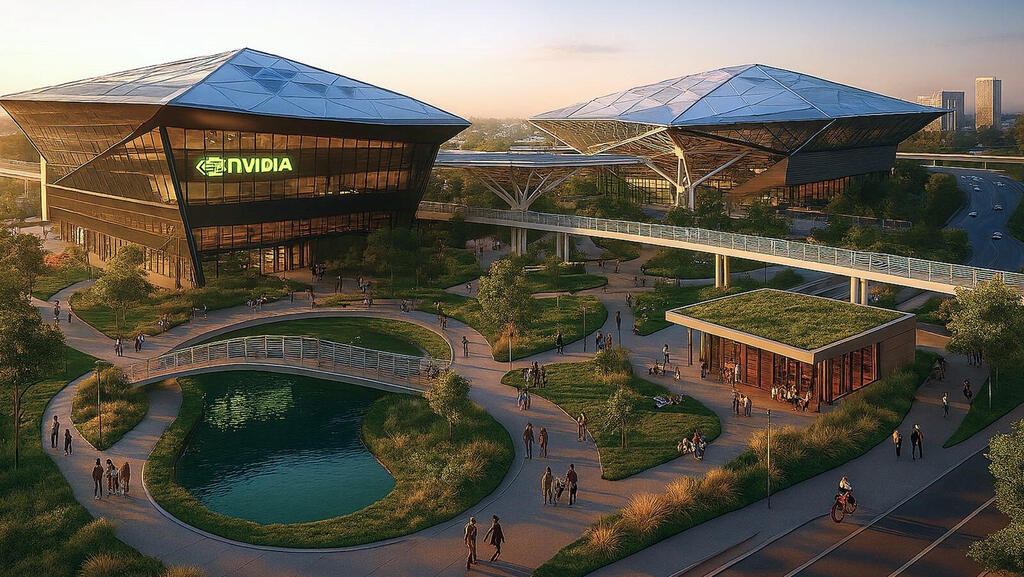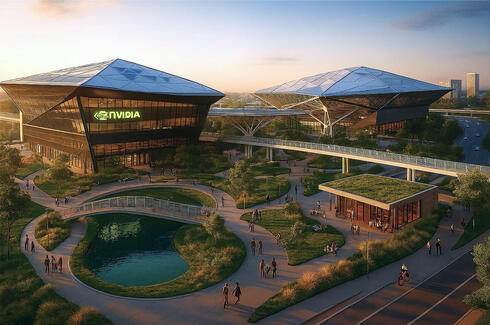
Nvidia’s land hunt sets off bidding war
From academic proximity to free plots, the battle for Nvidia’s new Israel campus is heating up.
Nvidia's announcement two weeks ago that it was seeking a large plot of land to house its new Israeli headquarters sent the entire northern region, and parts of the Sharon area, into high alert. At the end of last week, the two-week bid submission window closed, and Nvidia was surprised to find that some of the dozens of proposals it received came from municipalities outside the geographic radius it had set.
According to a partial list compiled by Calcalist, municipalities that submitted land offers include Migdal HaEmek, Safed, Haifa, Nesher, Harish, Ariel, and Netanya. The entire process is being coordinated by real estate consultancy Colliers, and the review of offers is expected to take several months.
The $4 trillion AI chip giant, currently the most valuable company in the world, announced publicly that it is seeking 70 to 120 dunams (17–30 acres) of land with continuous building rights for 80,000 to 180,000 square meters of construction. Ideally, the plot should be near Nvidia’s current offices in Yokneam. The company is open to working with kibbutzim and moshavim that can provide the necessary land. The search area spans from Zikhron Yaakov in the south to the Krayot region in the north.
However, Nvidia’s ideal is proving hard to match. Many municipalities are eyeing the success of Yokneam, Kiryat Tivon, Zikhron Yaakov, and Binyamina, and want to replicate it. Officials in several cities argue that because there are few suitable plots left near Yokneam, Nvidia may be open to extending its search radius. Leading candidates include Haifa and the Mevo Carmel industrial zone, where Nvidia is already building a data center. If Mevo Carmel had met all the criteria, Nvidia likely wouldn’t have issued a public RFI.
A fierce competition has now emerged among municipalities, especially smaller or economically weaker ones, seeking to become Nvidia’s next home. Nvidia currently employs 5,000 people in Israel, and the new campus is expected to double that number, making it the largest private employer in the country within a few years. While Nvidia will maintain its Tel Aviv offices (where it is soon to occupy half of the Rubinstein Twin Towers), the new hub will impact far more than its employees. It will generate jobs across catering, administration, security, transportation, and beyond.
Related articles:
Though the government is attempting to steer Nvidia to the country’s northern or southern periphery, it is expected that the company will prioritize proximity to talent pools over tax incentives. Nvidia has added 1,000 employees each of the past two years but is still struggling to fill many open positions.
Each city is marketing itself with its own unique strategy. For example, the Mevo’ot HaHermon and Hatzor HaGlilit regional councils are proposing a “village for the brains”, offering not just land for Nvidia’s HQ, but free land for employees willing to relocate.
Ariel, situated beyond the Green Line, is banking on a recent government sovereignty vote. It has offered 315 dunams in its Western Industrial Zone, backed by an approved urban plan, in hopes of positioning itself as a "national innovation capital."
Harish, located just 15 kilometers beyond Nvidia’s southern radius, emphasizes its accessibility to Highway 6 and future rail lines. It secured approval from the Israel Land Authority to offer 130 dunams, partially owned by the city and the Authority.
Netanya also entered the fray with an elaborate pitch that includes a simulated rendering of Nvidia’s future headquarters. The city is promoting itself as a “global technology hub” tied to academia and community life. It highlights accessibility, while sidestepping its notorious traffic, and is banking on an approved 35,000 sqm, 42-megawatt server farm, a crucial asset for Nvidia’s data-intensive operations. However, land prices in Netanya are much higher than in the north, as highlighted by IKEA’s recent half-billion-shekel purchase of its leased complex.
Migdal HaEmek, long aspiring to be Israel’s “chip capital,” also submitted a bid. It is home to Tower Semiconductor, which nearly sold to Intel for $6 billion before regulatory issues derailed the deal. Migdal HaEmek is designated a National Priority Area A, offering grants and benefits, but these come with obligations and state oversight Nvidia may prefer to avoid.
Migdal HaEmek is just 20 kilometers from Yokneam and near top academic institutions such as the Technion and University of Haifa. The mayor has already reached out to Nvidia and invited executives for a tour.
Meanwhile, cities like Safed have lobbied the government to help attract Nvidia even further north. But unlike Intel, Nvidia seems uninterested in working with the state. The government was reportedly caught off guard by Nvidia’s plans, and a wave of outreach to Nvidia executives began only after the public RFI.
The Knesset’s Special Committee for Strengthening the Negev and Galilee held an emergency session, urging the state to prepare a package of incentives. But according to Finance Ministry representative Asael Tzur, “We were surprised by the move and have limited capacity to respond.” Two government teams are now drafting potential benefit frameworks. Michal Fink from the Economy Ministry added, “We’ve reached out to the company, but it’s clear Nvidia will make its own decision.”
Officials from the Israel Land Authority’s Northern District have also met with Nvidia and proposed available plots, including in Beit She’an’s industrial zone.
